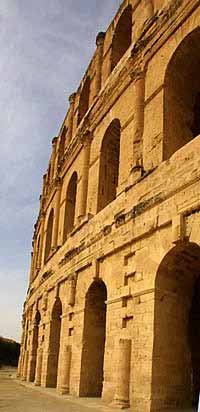|
t r a v e l s n a p zT r a v e l t h e w o r l d f o r j u s t a f e w c l i c k s |
||||
Guestbook |
Welcome to the Amphitheatre of El Jem, Tunisia |
|||

The outside of the amphitheatre. The structure was placed on the UNESCO list of significant sites in 1979. |
The third largest amphitheatre of the ancient Roman world stands at El Jem, the old Roman city of Thysdrus. It was built in the 2nd Century AD and seated some 30000 patrons of the arts (and other sports) in its three arcaded storeys that rise 30 metres into the air.You will spot the amphitheatre as you approach El Jem. The sandstone arches tower above the other more mundane buildings of the town. In another time, and in other circumstances, the sight of the structure and the fate that may have awaited you would not have given you pleasant thoughts. When the Colosseum like structure was built, El Jem was a thriving city in the centre of a vast olive gowing area. The city also contained many Roman villas that were owned by the merchants of the town. Many fine archeological finds have been discovered in this area, some of which are displayed in the local museum. We made the trip to El Jem as a day trip from Kairouan. We caught a louage to Sousse, and then another to El Jem. The louage drive was keen to get our custom back to Sousse, and he arranged to pick us up later in the day. The amphitheatre has an elongated oval "playing" area which is about 65 meters long. The partially exposed basement underneath the playing area has two vaulted galleries where the wild animals and the other unfortunates who were to be the "sport" of the day were kept. The sandstone for the building was hauled about 30 kilometers from the coast. The stone is quite soft so there is not much ornamentation on the building. During the Vandal invasion (430 AD) and when the Arabs attacked in 647 AD, the locals used the structure as a safehaven. Again, in the 17th Century, some Arab dissidents sheltering there were routed out when a hole was blasted in one side of the building. In addition to being used as an inexhaustible quarry to build the more modern buildings in the town, some of the stone was also used in building the Great Mosque in Kairouan. Luckily this quarrying has ceased and much of the structure still remains. |
|
You can see a wide view of the amphitheatre at:  |
The seating arrangements of the amphitheatre reflect the divisions in Roman society. The emperor (or in the case of El Jem, the local governor, had a special box for himself and his family. Senators (or local officials) sat in their own special section. Higher up the tiers, soldiers were separated from civilians, married men from bachelors. Boys and their tutors usually sat together. Women (except for the Vestal Virgins who sat in the best seats with other religious officials) sat with the poorest men in the top tier. The amphitheater was a place of order In El Jem, you can stride out onto the arena, lift your eyes to the imaginary crowd, draw your sword and wait for the opposing gladiator to make his move. Goodluck. But wait, that is not a sword in your opponent's hand - it is a conductor's baton! And that sound that could have a wild beast is just the orchestra tuning their instruments. The entertainment that is witnessed in the arena today is an annual international festival of symphonic music, usually held in the July/August period. And if you come to El Jem for the festival, your first sighting of the amphitheatre will be with anticipation, not dread. |
|
The postage stamp image |
 where the
victory of the civilized world (in the Roman view) over
lawlessness, barbarism, and savagery was regularly enacted. It
was also a place of justice with certain criminals and prisoners
of war being executed by being given to the wild beasts or forced
to fight to the death as gladiators.
where the
victory of the civilized world (in the Roman view) over
lawlessness, barbarism, and savagery was regularly enacted. It
was also a place of justice with certain criminals and prisoners
of war being executed by being given to the wild beasts or forced
to fight to the death as gladiators.